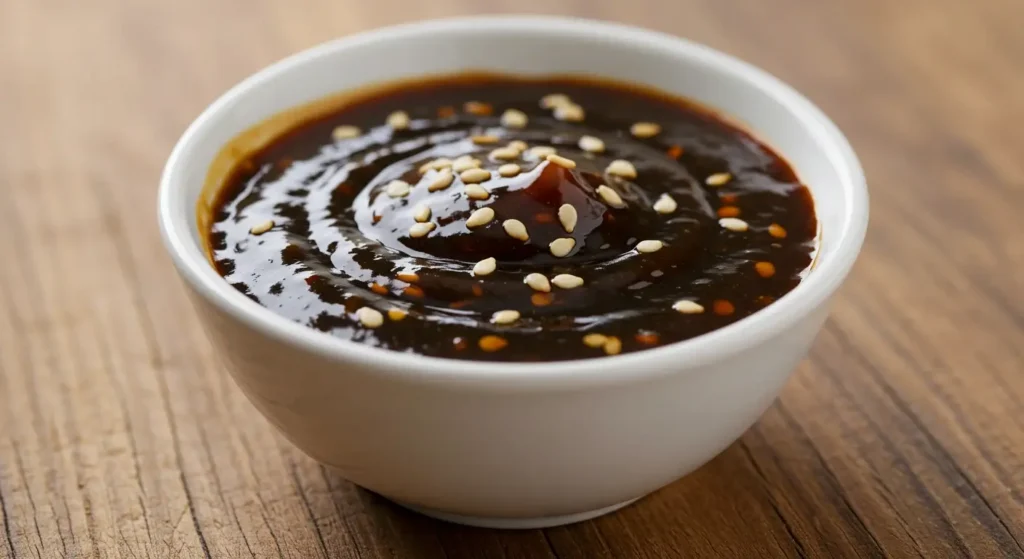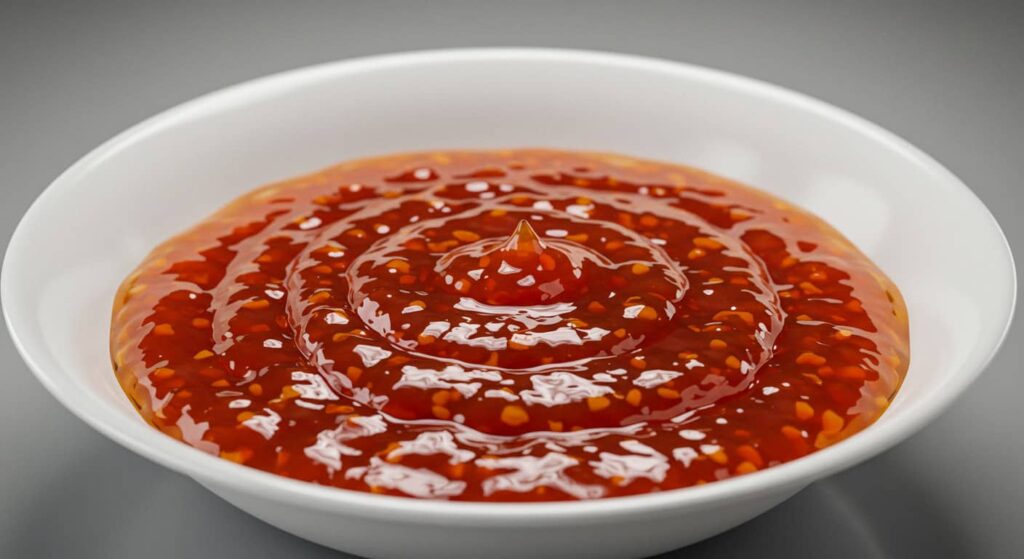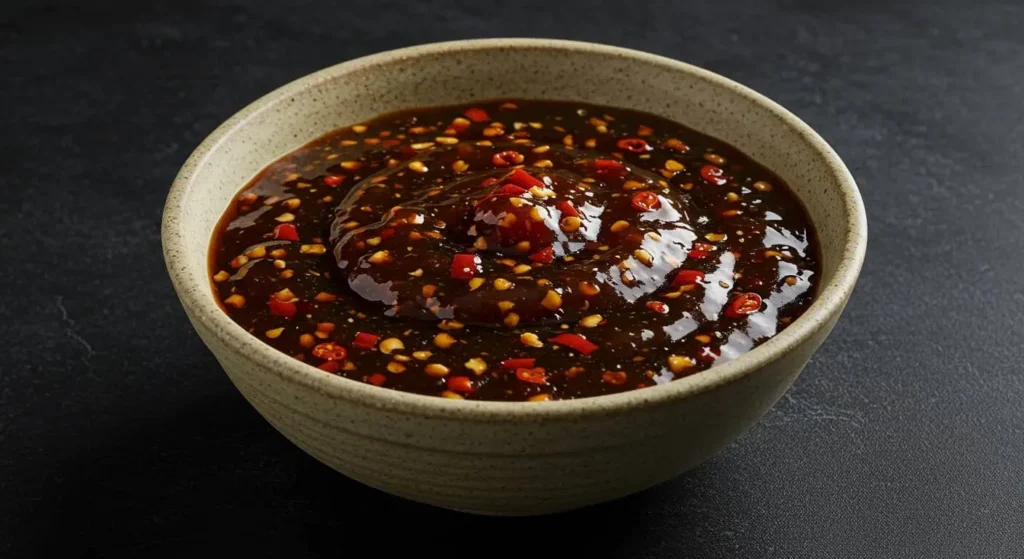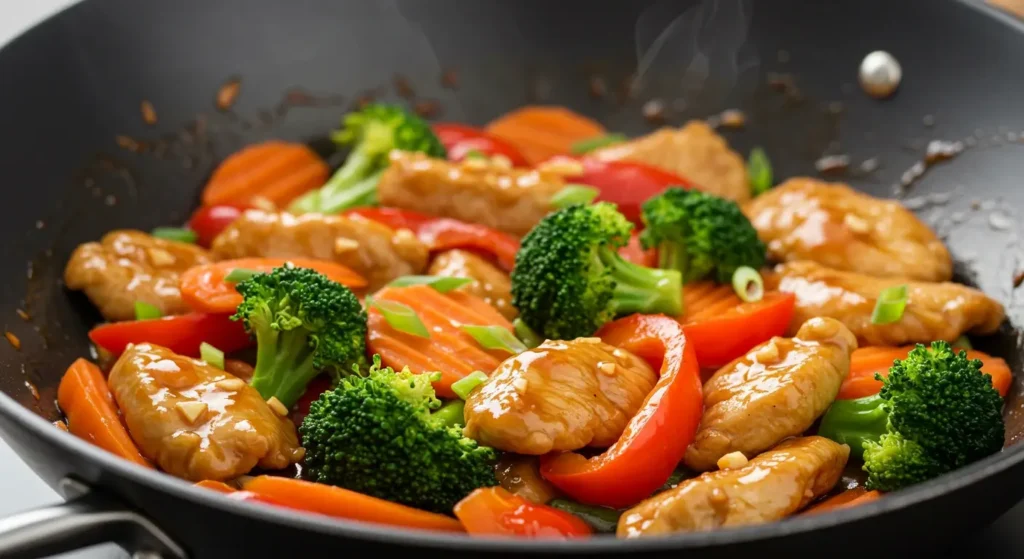Hey there, fellow food lovers! Are you ready to embark on a flavor adventure that will transform your stir fry nights from ordinary to extraordinary? Well, buckle up because we’re diving into the top 3 favorite sauces for stir fry! 🌟 These sauces not only jazz up your meals but also bring a delightful punch of taste that’ll have you and your friends coming back for seconds (or thirds!). Whether you’re a seasoned chef or a kitchen newbie, you’ll find something here that tickles your taste buds and is super simple to whip up. Ready? Let’s go!
Table of contents
Stir Fry Sauces
What is Stir Fry?
First things first, let’s talk about stir fry itself. Picture this: vibrant vegetables, tender proteins, and a whirlwind of flavors all coming together in one sizzling pan. Pretty awesome, right? Stir frying is a cooking technique that originated in China, where ingredients are quickly tossed in a hot wok with a small amount of oil. The result? Meals that are not only quick to prepare but also deliciously fresh and nutritious! 🥦🍗
The Importance of Choosing the Right Sauce
Now, here’s where the magic happens. The right sauce can elevate your stir fry from ho-hum to mouthwatering! The sauce adds depth, complexity, and that lip-smacking taste we all crave. Think of it as the secret superhero of your dish—without it, things can get a little bland. And nobody wants a boring dinner, right? So, let’s dive into our top 3 sauces that are sure to impress!
Top 3 Favorite Stir Fry Sauces Overview
Sauce 1: Soy Sauce Based Stir Fry Sauce
Ingredients of Soy Sauce Based Stir Fry Sauce

Here’s a classic that’s always a winner—soy sauce! Let’s take a closer look at what makes this sauce so special. The base usually consists of:
- 1/2 cup soy sauce
- 2 tablespoons sesame oil
- 2 tablespoons rice vinegar
- 1 tablespoon sugar (for a hint of sweetness)
- 1 teaspoon minced garlic
- 1 teaspoon grated ginger
Nutritional Benefits
On top of its fantastic flavor, soy sauce is also lower in calories compared to many other sauces. Plus, it contains amino acids which are beneficial for your body! But watch out; it can be high in sodium, so balance it with some fresh veggies! Here’s a quick Nutrition Facts table:
| Nutrient | Per Serving (1 tbsp) |
|---|---|
| Calories | 10 |
| Sodium | 900 mg |
| Protein | 1 g |
Popular Dishes Using Soy Sauce Based Stir Fry Sauce
This sauce is super versatile! You can use it in chicken stir fry, beef stir fry, or even a tofu stir fry for our vegetarian friends. It’s like the little black dress of sauces—perfect for any occasion. 🥡
Sauce 2: Sweet and Sour Stir Fry Sauce
Ingredients of Sweet and Sour Stir Fry Sauce

If you love a bit of zing, sweet and sour sauce will be your new best friend. Here’s what you’ll need:
- 1/4 cup ketchup
- 1/4 cup apple cider vinegar
- 1/4 cup sugar
- 1 tablespoon soy sauce
- 1 teaspoon cornstarch (for thickening)
Nutritional Benefits
Sweet and sour sauce brings a delightful contrast of flavors. It’s usually higher in sugar, but that’s what gives it that party-in-your-mouth vibe. Just remember, moderation is key! Check out the quick Nutrition Facts below:
| Nutrient | Per Serving (1 tbsp) |
|---|---|
| Calories | 30 |
| Sugar | 7 g |
| Sodium | 200 mg |
Popular Dishes Using Sweet and Sour Stir Fry Sauce
This sauce works wonders in dishes like sweet and sour chicken or shrimp. The blend of sweet and tangy will have your taste buds singing—the ultimate flavor duet! 🎶🍤
Sauce 3: Spicy Garlic Stir Fry Sauce

Ingredients of Spicy Garlic Stir Fry Sauce
Now, if you’re looking to crank up the heat, you’ll want a spicy garlic sauce. Grab these ingredients:
- 1/4 cup soy sauce
- 2 tablespoons chili paste (more if you’re brave!)
- 2 tablespoons minced garlic
- 1 tablespoon honey (for balance)
- 1 tablespoon vinegar
Nutritional Benefits
Spicy garlic sauce is not just tasty; it can also give your metabolism a little boost thanks to the chili. Here’s a Nutrition Facts breakdown:
| Nutrient | Per Serving (1 tbsp) |
|---|---|
| Calories | 25 |
| Sodium | 600 mg |
| Sugar | 4 g |
Popular Dishes Using Spicy Garlic Stir Fry Sauce
This sauce is perfect for any stir fry that needs a kick! Think spicy chicken or sizzling veggie stir fry. It’s like an exciting roller coaster for your taste buds! 🎢✨
How to Make Each Sauce from Scratch
Homemade Soy Sauce Based Stir Fry Sauce Recipe
Alright, let’s get our hands dirty and start making these sauces at home! First up, the soy sauce based stir fry. It’s as simple as 1-2-3! Mix your ingredients in a bowl, whisk them together until they’re well blended, and voila! You’ve got yourself a fantastic soy sauce base. Use it immediately or let it sit for a bit to deepen the flavors. 🤗
Homemade Sweet and Sour Stir Fry Sauce Recipe
Next, for the sweet and sour sauce. Combine ketchup, apple cider vinegar, sugar, soy sauce, and cornstarch in a saucepan. Heat it up while whisking until the sugar dissolves and the sauce thickens. Trust me, your kitchen will smell heavenly! 🍅🔥
Homemade Spicy Garlic Stir Fry Sauce Recipe
Finally, let’s make that spicy garlic sauce. Simply mix soy sauce, chili paste, minced garlic, honey, and vinegar in a small bowl. Feel free to adjust the heat level—add more chili paste if you dare! This sauce is bold and packs a punch, perfect for those who love their food spicy! 🌶️👌
Common Problems and Solutions When Using Stir Fry Sauces
Problem 1: Sauce Too Salty
“If your sauce tastes like the ocean, you might have overdone it on the soy sauce!”
Solution: Balancing the Flavors
No worries if your sauce turns out too salty; it happens to the best of us! Simply add a splash of water or some sugar to help balance things out. You could also throw in some extra veggies to dilute the saltiness. Voila, problem solved! 🌊✨
Problem 2: Sauce Not Thickening Properly
“A sauce that’s too runny is like a book without a plot—it just doesn’t work!”
Solution: Using Cornstarch or Arrowroot
If your sauce isn’t thickening up, you can make a quick slurry. Mix a tablespoon of cornstarch with cold water and add it to your sauce while it’s simmering. This will help thicken it up faster than you can say ‘stir fry’! 📖🥡
Problem 3: Sauce Lacks Depth of Flavor
“Not all heroes wear capes; some come in the form of aromatics and seasonings!”
Solution: Adding Aromatics and Seasoning
Finally, if your sauce tastes flat, don’t hesitate to add more garlic, ginger, or even some fresh herbs. A bit of lime juice can add brightness as well! It’s like giving your sauce a little boost of confidence, making it ready to shine! 💪🥬
Tips for Pairing Sauces with Vegetables and Proteins
Best Vegetables to Use for Each Sauce

When it comes to veggies, think colorful! Bell peppers, broccoli, carrots, and snap peas are all fantastic options. They not only add nutrients but also a delightful crunch that complements our beloved sauces. Here’s a quick rundown:
- Soy Sauce: Excellent with broccoli and snap peas for a classic combo.
- Sweet and Sour: Pairs beautifully with bell peppers and pineapple for a tropical twist.
- Spicy Garlic: Try it with green beans or mushrooms for an earthy kick!
Best Proteins to Use for Each Sauce
Now, let’s not forget the protein! Chicken, beef, tofu, and shrimp all make amazing choices. Mix and match with the sauces to find your perfect flavor pairing:
- Soy Sauce: Great for beef or chicken.
- Sweet and Sour: Delicious with chicken or pork.
- Spicy Garlic: Tofu or shrimp will take this sauce to a whole new level!
Stir Fry Cooking Techniques for Perfect Dishes
Preparation Before Cooking
Alright, you’ve got your sauce ready and veggies chopped, but preparation is key! Make sure everything is within arm’s reach—chopsticks or spatula in hand while the wok is heating up is a must! 🍳 Time is of the essence in stir frying, so having your ingredients prepped will help you stay on track.
Cooking Method: High Heat, Quick Movement
When cooking, crank that heat! Stir frying is all about high heat and quick movement. This locks in flavor and keeps your veggies vibrant and crisp. Toss everything together often—it’s like a dance party in your pan! 💃🔥
Finishing Touches: Timing the Sauce Addition
Don’t forget—with stir fry, timing is everything! Add your sauce at the end but give it a few moments to heat up and meld together with your dish. It’s like the icing on the cake that brings everything together! 🎂✨
Perfecting Your Stir Fry Experience
Welcome back, aspiring chefs! In this part, we’re going to dive deeper into the world of stir fry. We’ve already covered a few fantastic sauces, but there’s so much more to learn to ensure your stir fry experiences are flavorful, fun, and fabulous! 🎉 So, grab your apron and let’s get cooking!
Choosing the Right Ingredients for Stir Fry
The Importance of Fresh Ingredients
Now, let’s talk about freshness. Using fresh ingredients is like adding a splash of sunshine to your dish! Not only do fresh veggies and proteins taste better, but they also pack more nutrients. When you’re at the grocery store or farmers’ market, look for vibrant colors and firm textures. Choosing seasonal vegetables can also ensure you’re getting the best flavor possible. 🌽🥕
Proteins: What Works Best?
When it comes to proteins, the world is your oyster (or chicken, or tofu)! Here’s a quick breakdown:
- Chicken: Lean and versatile. You can use breast or thigh, depending on your preference.
- Beef: Tender cuts like sirloin or flank steak work wonders! Just slice it thin for faster cooking.
- Shrimp: Quick-cooking and juicy, shrimp takes on flavors beautifully!
- Tofu: An excellent protein choice for vegetarians! Firm tofu absorbs sauces like a sponge!
Vegetables: Mixing Colors and Textures
Don’t skimp on the color! A rainbow of vegetables makes your stir fry not only more appealing but also more nutritious. Here are some great options:
- Bell Peppers: Add a punch of sweetness and color.
- Broccoli: Provides crunch and packs a nutrient punch!
- Snap Peas: Sweet and crisp, they cook up quickly and enhance the texture!
- Carrots: Slice them thin for a sweet note and a pop of orange!
Herbs and Aromatics for Extra Flavor
Besides sauces, don’t forget about herbs and aromatics! Fresh garlic, ginger, and green onions can add a flavor depth that elevates your stir fry. Here’s a little tip: sauté garlic and ginger in the hot oil before adding your other ingredients to release their fragrant oils—your kitchen will smell amazing! 🌿✨
Different Styles of Stir Fry
Classic Stir Fry Techniques
When it comes to stir frying, there are a few techniques that will help you perfect your craft, and each brings something unique to your dish. Let’s break it down:
1. High Heat Stir Fry
This is the classic method. Use a wok or a large skillet, heat up your oil until it’s shimmering (but not smoking!), and add your ingredients in batches. Starting with proteins followed by denser vegetables then lighter ones ensures everything cooks evenly. It’s a quick toss-and-sizzle approach that seals in flavors! 🔥👩🍳
2. Steaming and Stir Fry
For a healthier spin, you can briefly steam your veggies before adding them to your stir fry. This technique softens tough vegetables while keeping them crisp and bright. Just toss them in after your protein is cooked, add a splash of water, and cover for a minute or two. It’s like giving them a quick spa day before the big cooking party! 🌊😌
3. Cold Stir Fry
Have leftovers? You can also try a ‘cold’ stir fry where cooked ingredients are tossed in a hot sauce and quickly sautéed to heat through. This method helps keep the veggies crispy and bright while ensuring everything is quick and hassle-free! Perfect for busy weeknights! 🥡🚀
Exploring Global Influences on Stir Fry
Asian Inspirations
Stir fry is heavily rooted in Asian culinary traditions, but its influence stretches far beyond that! Here are a few global twists to inspire your cooking:
1. Thai Stir Fry
Love a little sweetness with heat? Thai stir fries often incorporate ingredients like basil, lime juice, and fish sauce. A Thai basil chicken stir-fry can be a beautiful way to mix these elements and bring an entirely new flavor profile to your dinner table! 🌶️🍃
2. Korean Stir Fry
Korean dishes like bulgogi (marinated beef) can be stir-fried alongside colorful vegetables. The key ingredient here would be gochujang—Korean chili paste—adding a unique blend of sweet, spicy, and savory flavors! 🥢🇰🇷
3. Fusion Stir Fry
Feeling adventurous? Try a Mexican twist with peppers and corn tossed in a spicy garlic sauce topped off with avocado, cilantro, and a touch of lime juice. Fusion dishes can surprise your taste buds with delightful results! 🎉🌮
Serving and Presentation Tips
Mise en Place for Success
You know what they say—good things come to those who prepare! Before you start cooking, lay out your ingredients and have everything ready to go. This is called “mise en place,” and it’s a game-changer. It makes the cooking process smoother and prevents any last-minute scrambling! 🥅🧑🍳
Piling Up the Flavor: Layering Your Dishes
When serving your stir fry, don’t just dump it on the plate; think about adding layers. Start with a base of rice or noodles, then pile on the stir fry, and top with fresh herbs or sesame seeds for that beautiful finish. A sprinkle of chopped green onions can add a pop of color and flavor too! ✨🍚
Garnishing for Visual Appeal
Presentation is key! A nice garnish can turn a simple dish into a visual masterpiece. Think toasted sesame seeds, chopped cilantro, or even lime wedges to make it look appealing and fresh! Remember, we eat with our eyes first, right? 🍽️
Frequently Asked Questions (FAQs)
Question 1: What can I substitute for soy sauce?
If you’re looking for a soy sauce substitute, consider using coconut aminos or tamari for a gluten-free option. Both will still give you that umami flavor without sacrificing your dishes!
Question 2: How can I make my stir fry vegan?
Easy peasy! Switch out meats for plant-based proteins like tofu, tempeh, or even chickpeas. Pair them with your favorite veggies and sauces for a hearty vegan meal!
Question 3: Can I prep my stir fry ingredients in advance?
Absolutely! You can chop vegetables and marinate proteins a day or two beforehand. Just keep everything stored properly in the fridge to maintain freshness.
Question 4: What’s the best way to store leftover stir fry?
Store leftovers in an airtight container in the refrigerator. They can last 2-3 days, making them perfect for a quick lunch or dinner!
Conclusion: Your Stir Fry Adventure Awaits!
Congratulations on making it through this spicy journey of stir-fry mastery! From sauces to techniques and global inspirations, you now have a wealth of knowledge to create sensational stir fries at home. Remember, the kitchen is your playground—don’t hesitate to mix things up and let your creativity shine! What exciting stir fry creations will you come up with next? Let’s get cooking! 🎉🥡

